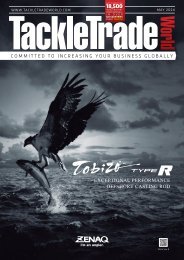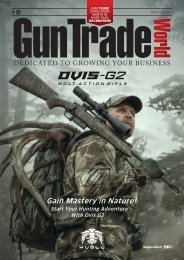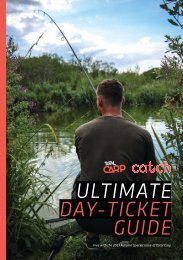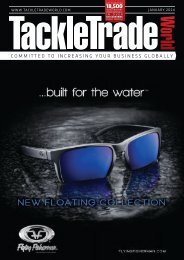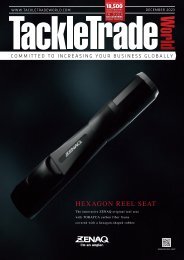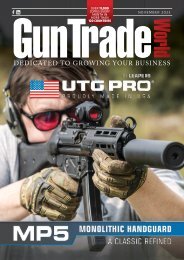Create successful ePaper yourself
Turn your PDF publications into a flip-book with our unique Google optimized e-Paper software.
DBW...<br />
Texas<br />
i n d u s t r y v i e w<br />
Everett Johnson, Editor and Publisher,<br />
Texas Saltwater Fishing Magazine<br />
Ask any Texan: “Everything’s<br />
bigger in Texas!” Some will<br />
go so far to add “… and<br />
better, too.”<br />
Texas hubris aside,<br />
Texas is a very large state,<br />
geographically speaking,<br />
with a rapidly expanding<br />
population. According to<br />
the latest from US Census<br />
Bureau, Texas now has more<br />
than 30 million people.<br />
Thanks to its powerful<br />
energy and petro-chemical<br />
sectors, and perhaps the<br />
single greatest reason the<br />
population continues to rise<br />
year over year, the Texas<br />
economy is largely insulated<br />
from economic cycles common<br />
in other US states. There’s an<br />
old saying: ”If you can’t f ind<br />
a job in Texas, you don’t want<br />
one.”<br />
Recreational f ishing<br />
is big in Texas, too. The<br />
Texas Parks and Wildlife<br />
Department (TPWD) report<br />
a marked upswing in f ishing<br />
licence sales of all types over<br />
the past decade. Current data<br />
indicates nearly 1.9 million<br />
licensed anglers. Economic<br />
impact of sport f ishing in the<br />
Lone Star State is more than<br />
$7.7 billion, according to<br />
Southwick Associates.<br />
Bass f ishing tops all other<br />
types of f ishing and, thanks<br />
to the conservation efforts of<br />
the bass f ishing community<br />
over recent decades, the<br />
quality of these f isheries is<br />
soaring off the charts. In the<br />
f irst three months of <strong>2023</strong><br />
alone, Texas waters have<br />
delivered more than a dozen<br />
Share-A-Lunker submissions<br />
– angler’s f ish weighing<br />
more than 12lb, kept alive,<br />
and contributed to TPWD’s<br />
hatchery programs with hope<br />
of passing along the superior<br />
genetics of trophy specimens.<br />
Saltwater f ishing is<br />
booming as well. The Texas<br />
coastline is said to be 367<br />
miles in length. But unlike<br />
many coastal states that<br />
have a relatively smooth<br />
coastline, if you look behind<br />
Texas’ nearly endless miles<br />
of barrier islands, the jagged<br />
shorelines of its major bays<br />
and estuaries are longer than<br />
600 miles.<br />
Texas saltwater angling<br />
can be classif ied into three<br />
major categories – inshore,<br />
nearshore, and offshore.<br />
Species targeted across the<br />
three categories range from<br />
billf ish and tuna offshore, to<br />
the most-highly-sought-after<br />
species being seatrout and red<br />
drum inshore, with dozens<br />
more in-between.<br />
Unlike many states, Texas<br />
is unique in the ability<br />
of recreational anglers to<br />
access Gulf beaches, and<br />
year-around surf f ishing<br />
is very popular. Primary<br />
species sought are red and<br />
black drum, tarpon, king<br />
mackerel, Spanish mackerel,<br />
and Florida pompano. Shark<br />
f ishing from the beach is<br />
also very popular. At least<br />
a dozen species are landed<br />
regularly, some weighing<br />
hundreds of pounds, and<br />
shark anglers take great care<br />
to return these f ish to the<br />
ocean unharmed.<br />
Inshore saltwater f ishing<br />
is another year-around<br />
angling pursuit, with<br />
likely a million or more<br />
participants annually.<br />
Texas bays as a whole are<br />
relatively shallow, which<br />
means that wade f ishing is<br />
a very popular way to access<br />
the f isheries. Some anglers<br />
quip that the only reason<br />
they own a boat is to get<br />
where they f ish… and then<br />
jump out. The popularity<br />
of wade f ishing creates a<br />
whole other category of gear<br />
and accessories not nearly as<br />
common in other places.<br />
The specialised type of<br />
f ishing boats commonly seen<br />
plying Texas bays are also<br />
an entity unto themselves. A<br />
product of angler’s desire to<br />
access the hundreds of miles<br />
of shallow lagoons of the<br />
middle and lower portions<br />
of the coast, in pursuit of<br />
spotted seatrout, red drum,<br />
and snook; almost nowhere<br />
but Texas can you f ind crafts<br />
designed to navigate in less<br />
than 2ft depths. As a result,<br />
many Texas anglers own<br />
two boats. One for shallow<br />
flats f ishing and a second<br />
for larger, deeper bays<br />
that also qualify for daytripping<br />
the nearshore Gulf<br />
in calm weather. Which in<br />
itself becomes a signif icant<br />
boost for boat building,<br />
outboard power, and marine<br />
electronics industries. The<br />
tackle industry also benef its<br />
mightily from Texas anglers<br />
who require a wider than<br />
normal range of equipment<br />
and gear necessary in their<br />
varied angling interests.<br />
The bottom line in the<br />
recreational angling industry<br />
is that without f ish we<br />
cannot have an industry…<br />
that’s pretty basic. So, with<br />
the population booming and<br />
licence sales steadily on the<br />
rise, what does the future<br />
hold for Texas anglers and<br />
the f isheries that support the<br />
industry? Fair question.<br />
The answer to that<br />
important question lies<br />
solely within in the realm<br />
of TPWD’s management<br />
plans… and also within the<br />
rapidly evolving sporting<br />
and conservation ethic of<br />
the recreational angling<br />
community.<br />
TPWD is both a role model<br />
and the most forward-thinking<br />
f isheries management agency<br />
in the country. Their work is<br />
copied in many ways; from<br />
f ishing regulations and<br />
interface with constituents,<br />
to stock enhancement (sport<br />
f ish hatcheries and stocking<br />
programs), to habitat creation<br />
and restoration. Texas<br />
anglers are also blessed to<br />
have the support of some of<br />
the nation’s leading f isheries<br />
research programs. The<br />
work accomplished over the<br />
past 50 years by scientists<br />
at the University of Texas<br />
Marine Science Institute<br />
and Texas A&M University<br />
Harte Institute, has helped<br />
tremendously. And let’s not<br />
forget the contributions of<br />
the Coastal Conservation<br />
Association. Without these<br />
combined efforts, Texans<br />
might not have so much to brag<br />
about. With them, the future of<br />
recreational angling in Texas<br />
remains bright.<br />
www.tackletradeworld.com<br />
29




